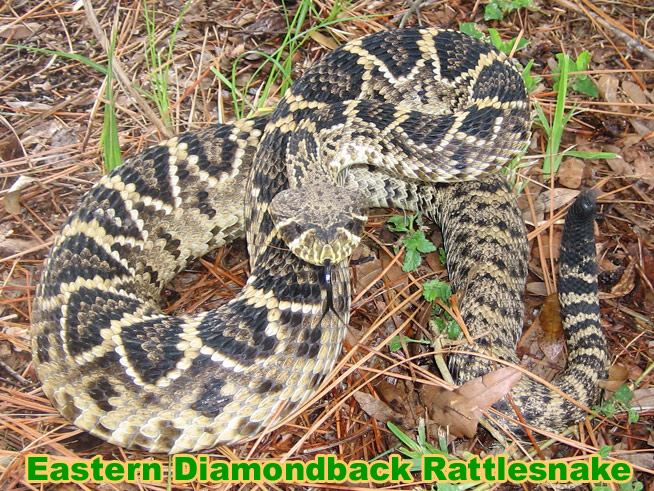
Diamondback Rattlesnake Appearance: the diamondback rattlesnake is the largest venomous snake in North America. These pit vipers can grow to be eight feet long and can weigh up to ten pounds. They are easily recognized by the black or brown diamond patterns down their body, outlined in a light shade of yellow. As their name implies, the rattlesnake has a series of hollow segments at the end of the tail which creates a rattle when shaken vigorously. These snakes have two heat sensing pits located between their eyes and nostrils, allowing them to strike prey during times of poor visibility.

Diamondback Rattlesnake Habitat & Behavior: There are three species diamondback rattlesnakes in the United States, and they collectively cover the majority of the southern, southwestern, and western states and some of Mexico. The rattlesnake’s habitat is anywhere with thick brush or vegetation. This snake hunts by ambush, and needs sufficient ground cover to sneak up on prey. They prefer dry areas and rocky landscapes, though they are often found curled near fallen trees and under logs.
Despite their reputation, rattlesnakes are not overly aggressive, and their rattle is more of a warning than a sign that a strike is imminent. If a diamondback rattlesnake cannot get away from a predator, it will then coil and shake its tail. When the snake no longer feels threatened, it will stop the warning. Sometimes rattlesnakes will shake their tails before they feel threatened, just to let potential predators, such as coyotes, know they are present and should not be messed with.
The rattle of the snake’s tail is made of hollow segments. Each time the snake sheds—which can be up to three times a year—the tail will grow a new segment. These rattle pieces will break off with time, so it is not possible to tell a rattlesnake’s age accurately by the length of its rattle. Without predation, diamondback rattlesnakes can live up to twenty years or longer.
Female snakes incubate eggs inside of their bodies, giving birth to live young of ten or more. The gestation period is between 6 and seven months. Infant rattlesnakes are independent at birth. Instead of rattles, the ends of their tails are covered in a small nub.
Diamondback Rattlesnake Diet: The primary source of nutrition for the diamondback rattlesnake is rodents. Rabbits and birds make up smaller percentages of the diet, and prey variance depends largely on the location of the snake. Like most pit vipers, rattlesnakes will strike their prey, inject their venom, and allow the animal to leave the immediate area. The snake will then follow the scent trail to the carcass and consume the body in its entirety.
Diamondback Rattlesnake Facts:
The venom of a rattlesnake is considered to be hemotoxic. This type of venom attacks tissue cells, creating necrosis and destroying viable cells. It also prevents clotting and promotes hemorrhaging throughout the affected area.
Eastern diamondback rattlesnakes have the longest fangs of any rattlesnake species.
The population of diamondback rattlesnakes has been steadily declining. Some areas host “rattlesnake roundups” where large numbers of the snakes are hunted down and killed. Despite the disappearance of the species, there are no laws protesting the rattlesnake. Since 1996, over 200,000 pounds of rattlesnakes have been killed through these roundups.
Diamondback rattlesnakes will often live in the burrows of animals they have kicked out.
In areas where cold weather is present for extended periods of time, the rattlesnake will hibernate.
Despite living most of their lives on the ground, when the need presents itself, the diamondback rattlesnake can easily climb textured, vertical surfaces such as tree trunks. They are also sufficient swimmers and have been known to populate certain islands off the eastern coast of the United States.
Rattlesnake meat is highly prized by people in certain areas of the country and is often served broiled or slow roasted to prevent it from drying out.
Click here for a story about a Western Diamondback Rattlesnake Removal situation.
Many people want to know how to kill a Diamondback snake, but you don't need to. The best way to get rid of Diamondbacks is to simply leave them alone. You can also use a Diamondback trap to catch them - that's one of the best ways for how to remove Diamondback snakes. For more information, go to my Snake Removal - How to Get Rid of Snakes home page.